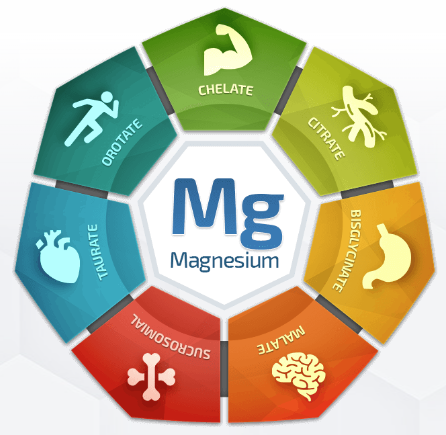Magnesium is an essential mineral that plays a vital role in numerous physiological functions within the human body. More than 300 enzymatic reactions involve magnesium, contributing to various biochemical processes necessary for overall health and well-being.
Muscle and nerve function, energy production, bone health and heart health need adequate levels of magnesium, obtained through a balanced diet rich in magnesium-containing foods or through supplements. This contrinui significantly for overall health and well-being.
There are several types of magnesium supplements available, each with its own unique properties, absorption rates and specific uses.
Here we will see:
ToggleMagnesium – what is it for?
So, what is the importance of magnesium for health?
- Muscle Function: Magnesium helps muscles contract and relax, which is essential for movement and overall physical function.
- Magnesium participates in the synthesis of ATP (adenosine triphosphate), which is the primary energy currency of cells.
- Bone Health: Magnesium works in conjunction with calcium and vitamin D to support bone structure and prevent conditions like osteoporosis.
- Heart Health: It supports cardiovascular health by helping regulate heart rhythm, blood pressure, and overall heart function.
- Nervous System Function: Magnesium acts in neurotransmitter regulation, aiding in the proper function of the nervous system. It contributes to mood regulation and helps alleviate stress and anxiety.
- Regulation of Blood Sugar Levels: Magnesium is involved in insulin secretion and function, influencing blood sugar control.
- DNA and RNA Synthesis: It participates in DNA and RNA synthesis, contributing to genetic material and protein production within cells.
Magnesium – how many types are there?
As mentioned before, there are several types of magnesium supplements available. Let’s see each of them?

- Magnesium citrate: It has high bioavailability. The body absorbs more easily and helps support digestive health and relieve constipation.
- Magnesium Glycinate or bisglycinate: It is linked to the amino acid glycine. It has excellent bioavailability and causes less digestive discomfort compared to other forms. Helps in relaxation, muscle cramps and to support overall well-being.
- Magnesium Oxide: Has lower bioavailability compared to other forms. We easily find this type in over-the-counter supplements, but it can cause gastrointestinal side effects in some individuals.
- Magnesium Malate: It is a compound of magnesium and malic acid, known to support energy production and can help in fatigue and/ or fibromyalgia.
- Magnesium L-Threonate: It has the potential to penetrate the blood-brain barrier, so it helps with cognitive support and brain health.
- Magnesium Chloride: Often found in topical applications, it is often used for muscle relaxation or to relieve pain.
- Magnesium Sulfate: Commonly known as Epsom salt, is used in baths for relaxation and relief of muscle pain. It is absorbed by the skin during bathing, therefore not ingested.
- Magnesium Taurate: This form combines magnesium with taurine, an amino acid. It’s often used for cardiovascular support and to maintain healthy heart function.
- Magnesium Chelate: This form of magnesium is especially important for muscle building, recovery, and health.
- Magnesium Sucrosomial: This form of magnesium helps you to effectively produce energy. It also supports the immune system and is critical for bone health and skeletal development.
- Magnesium orotate: Although it is also useful for the heart, magnesium orotate can also improve metabolism. This makes it a favorite for athletes seeking enhanced recovery, energy and performance.
So, what magnesium do I need?
As we have seen, each type of magnesium supplement has its own absorption rate, bioavailability and specific uses. The choice of magnesium supplement often depends on individual needs, such as correcting deficiencies, improving absorption or targeting specific health concerns. Therefore, it is advisable to consult a healthcare professional to determine the most appropriate type and dosage of magnesium supplement based on individual health needs.
Is it possible to supply magnesium only with food?
Food Sources of Magnesium
Several food sources may provide magnesium, for example:
- Leafy green vegetables (spinach, kale)
- Nuts and seeds (almonds, cashews, pumpkin seeds)
- Legumes (beans, lentils)
- Whole grains (brown rice, quinoa)
- Some fruits (avocado, bananas)
- Seafood (salmon, mackerel)
- Dark chocolate
But you can’t always get the magnesium your body needs from food alone. In some cases that’s not possible. Why not?
When is it necessary to supplement magnesium?
It may be necessary to supplement magnesium in various situations where individuals may not get enough magnesium through their diet or when specific health conditions or factors lead to a deficiency. Some cases where magnesium supplementation may be necessary include:
- Diet low in magnesium-rich foods
- Gastrointestinal Disorders can impair magnesium absorption, leading to deficiencies that may require supplementation.
- Some health conditions, such as type 2 diabetes or use of medications, such as diuretics, can deplete magnesium levels.
- Athletes and Exercise-Induced Depletion: Intense physical activity can lead to magnesium loss through sweat. Intense exercise can lead to the need for additional magnesium to replenish adequate levels.
- Chronic Stress or Insomnia: Supplementing with magnesium might help support relaxation and promote better sleep quality.
- Or when the body has symptoms of magnesium deficiency.
What are the symptoms of magnesium deficiency?
Magnesium deficiency, also known as hypomagnesemia, can manifest in various symptoms. These signs and symptoms can vary in severity depending on the level of deficiency. Some common symptoms of magnesium deficiency include:
- Muscle Cramps and Spasms: Often seen as one of the earliest signs
- Fatigue and Weakness: Feeling unusually tired, weak, or lethargic even after adequate rest.
- Irregular Heartbeat: Deficiency may result in palpitations, irregular heartbeats, or arrhythmias.
- Nausea and Vomiting: Some gastrointestinal symptoms like nausea, vomiting, or loss of appetite.
- Numbness or Tingling: Numbness, tingling, or abnormal sensations in the extremities.
- Personality Changes and Mood Swings: Anxiety, irritability, mood swings and even depression relate to low magnesium levels.
- Muscle Weakness: In addition to cramps, generalized muscle weakness or a feeling of overall weakness may occur.
- Seizures: Severe magnesium deficiency can, in rare cases, lead to seizures or convulsions.
- Abnormal Heart Function: Extremely low magnesium levels might cause more serious complications affecting heart function.
Several health problems can cause these symptoms, but experiencing one or more of these symptoms does not necessarily confirm a magnesium deficiency.
If you suspect a deficiency or experience concerning symptoms, it’s important to consult a healthcare professional for proper evaluation and diagnosis.
The patient needs to measure magnesium levels to provide adequate guidance or treatment if a deficiency is confirmed.
Magnesium – How to Take
The usual dosage is one or two capsules a day, but a doctor or nutritionist should prescribe the appropriate dose, according to the person’s needs. Generally, the recommended daily dose of magnesium for adults ranges from 320 mg (women) and 420 mg (men).
Now that we answer the main question: Magnesium – what it is used for and how many types there are, there are two important questions left. Let’s see.

Where to buy reliable magnesium supplements?
Today on the market there are few magnesium supplements that combine two or more types of magnesium in the same formula. This leads people to make separate use of different types of magnesium for different needs, making the treatment much more expensive.
However, searching carefully, I found a supplement that brings together at least 7 types in a single formula. It is worth knowing.
Visit the OFFICIAL PAGE of Magnesium Breakthrough – BiOptimizers by clicking below.
Related article: Magnesium glycinate and bisglycinate – is there a difference?



